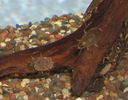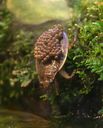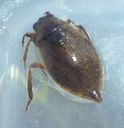Abedus
Abedus
Classification
- Phylum: Arthropoda
- Subphylum: Hexapoda
- Class: Insecta
- Order: Hemiptera
- Suborder: Heteroptera
- Infraorder: Nepomorpha
- Superfamily: Nepoidea
- Family: Belostomatidae
- Subfamily: Belostomatinae
- Genus: Abedus
Pronunciation
How to pronounce Abedus: //æˈbɛdəs//
These audio files are automatically generated. While they are not always 100% accurate, they are a good starting point.
Images






Summary
Abedus is a genus of giant water bugs within the family Belostomatidae. They are mostly found in freshwater environments across the southern United States, parts of Mexico, and Central America, noted for their predatory behavior and unique male parental care during reproduction.
Physical Characteristics
Members of the genus Abedus are typically brown and range from 2.3 to 4 cm (0.9–1.6 in) in length, with Abedus immaculatus being about 1.3–1.4 cm (0.51–0.55 in). They are easily recognizable by their strongly reduced forewing membrane.
Identification Tips
Different species within Abedus can only often be separated with a microscope due to their similar morphology.
Habitat
Freshwater habitats in southern United States, Mexico, and Central America.
Distribution
Southern United States, Mexico, and Central America.
Diet
Carnivorous; they are sit-and-wait predators that catch small invertebrates and small vertebrates, including young fish and tadpoles.
Life Cycle
After mating, females glue the eggs onto the male's back, where the male tends them until hatching. The nymphs go through five instar stages before reaching adulthood.
Reproduction
Male parental care is exhibited, with females attaching eggs to the male's back.
Ecosystem Role
As predators, they play a role in controlling populations of various aquatic invertebrates and small vertebrates.
Cultural Significance
Some species are displayed in zoos due to their unique breeding behaviors.
Health Concerns
They can bite in self-defense, resulting in pain but are not dangerous.
Collecting Methods
- Netting in freshwater habitats.
- Hand collection during overland travel after heavy rains.
Preservation Methods
- Ethanol preservation for specimens.
- Pinning for larger individuals.
Similar Taxa
Misconceptions
They are often referred to as ferocious water bugs, which may lead to an exaggerated fear of them despite their non-dangerous nature.
Tags
- insect
- water bug
- freshwater
- predator
- Belostomatidae